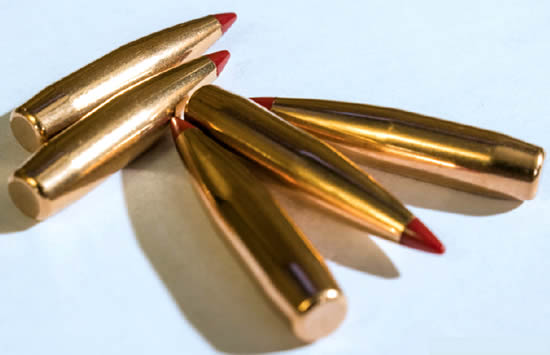The Excellent ELD-X
Hornady’s low drag, expanding bullet ‘delivers accuracy both at the bench and in the hunting fields.’
Story by Phil Massaro Photos by Massaro Media GroupThe rain had just subsided, though the streams were too swollen to cross. In spite of the fact that temperatures had risen significantly – the previous morning was in the low single digits – the runoff created a natural barrier between us and the mule deer buck we had just glassed on the hillside at over 1,000 yards.
So, with Plan A foiled, we regrouped and planted the seeds of what would become Plan B: glass the innumerable coulees, gullies and canyons in a frantic manner until we found a buck. Well-armed with both superior firepower and a positive mental attitude, we sallied forth, in spite of wet feet and rumbling bellies indicating the proximity to lunchtime.
My hunting partner Mike Mattly and I were discussing the finer points of magnum cartridges and domestic beer as we approached the first canyon we were to glass, when a pair of mule deer bucks – who obviously disagreed with my take on Coors Light – jumped out of their beds to find better conversation.
“On the left, he’s the one you want,” Mattly curtly stated. The rifle came quickly to shoulder, but a running mule deer will bounce more than run, so the shot wasn’t exactly a slam-dunk. Even through the recoil I could hear the bullet strike flesh, and Mattly’s congratulations assured the buck had gone down.
Mule deer bucks can be tough, but the 143-grain Hornady ELD-X bullet was tougher and, in spite of having almost 200 yards to slow down, worked perfectly. It was my first mule deer, and my first time in the field with the ELD-X, though it wouldn’t be the last for either one.

perfect choice for all the 6.5 cartridges,
from the Creedmoor to the 6.5-284
Norma up through the 6.5 PRC.

ELD-X at 200 grains will give
great performance in the .30-
06 Springfield and the .300
magnums alike. (HORNADY)
While we have the choice of a good many bullets, the ELD-X is among the finest for these situations. Let’s take a look at the design concepts, and at the eye-opening discoveries that led to its existence.


It became evidentthat something was happening to the polymer tip in flight, as the ballistic coefficient was dropping off rapidly as the bullet began to show the effects of atmospheric drag. The tips were melting due to friction, and that was causing the BC values to drop off significantly. So, Hornady’s engineers set to work to develop a tip that would hold up during flight, maintaining its conformation in order to help preserve the ballistic coefficient figures.

The result of their efforts was the proprietary Heat Shield Tip, which would resist the effects of atmospheric drag throughout the bullet’s trajectory, and it was a game-changer. The ELD-X bullet uses the Hornady AMP bullet jacket – prized for its concentricity – and a secant ogive and boattail for match-grade accuracy, in addition to an internal InterLock ring on the interior of the jacket, which will help keep the jacket and core together during the violent terminal phase of expansion. It is the companion bullet to Hornady’s ELD Match – a wonderful target bullet – and is almost, if not equally, as accurate.

There are two 6mm choices at 90 and 103 grains, a 110-grain .257-inch-diameter, that 143-grain 6.5mm that worked so well for me in South Dakota, a 145-grain .277-inch-diameter, three 7mm choices at 150, 162 and 175 grains, a quartet of .30s – 178, 200, 212 and 220 grains – and a pair of .338s at 230 and 270 grains. There are some stellar ballistic coefficients among this lineup, including the 175-grain 7mm, with a G1 BC of .689, and the 270-grain .338, with a G1 BC of .757; both of these will perform wonderfully at longer ranges. The 212-grain .308 – with a G1 BC of .673 – couples well with the larger magnum cases like the .300 RUM, .300 PRC, .300 Norma and .30-378 Weatherby Magnum. If you recover an ELD-X from your game animal, you will find a high level of weight retention, often in the high 80-percent range, which is typical of a heavy-for-caliber cup-and-core bullet with a decent jacket.
I like the ELD-X as a general hunting bullet for the common species such as hogs, black bears, whitetail and mule deer, caribou, elk and even moose, if the caliber is large enough for the larger cervids. For the dangerous species like grizzly bears, I’d prefer a bonded-core or monometal design, but for the majority of species, the ELD-X will work just fine. I’m not able to testify whether the Heat Shield Tip holds together during flight or not, as every fired bullet I’ve been able to recover has been so badly deformed that it was impossible to ascertain what happened in flight. Nor am I able to determine what happens to other polymer tips. But I do know the Hornady ELD-X does what I need it to do: it delivers accuracy both at the bench and in the hunting fields, and delivers the terminal performance needed to ensure a quick, humane kill.







